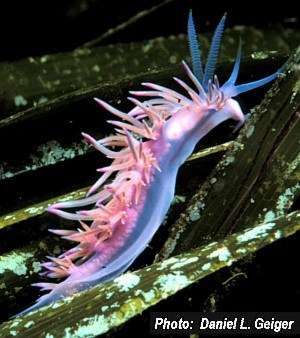
Flabellina affinis
(Gmelin, 1791)
Order: NUDIBRANCHIA
Suborder: AEOLIDINA
Family: Flabellinidae
DISTRIBUTION
Mediterranean, West Africa (Ghana).
PHOTO
Both animals photographed at Baleares, Menorca, Punta Prima, August 1989. LOWER LEFT: showing mating pair. LOWER RIGHT: showing ridges on rhinophores. PHOTOS: Daniel Geiger.
Grows to about 50mm long. Feeds on the hydroid Eudendrium.
A very similarly coloured species, Flabellina ischitana, has long been confused with Flabellina affinis. The differences between the two were enumerated by Hirano & Thonpson (1990) and more recently Cervera, Lopez-Gonzalez & Garcia-Gomez (1998). Essentially in Flabellina ischitana the ceratal surface is translucent, without violet colouration, while in Flabellina affinis there is an opaque violet zone, obscuring the digestive gland, just under the subapical white ring .
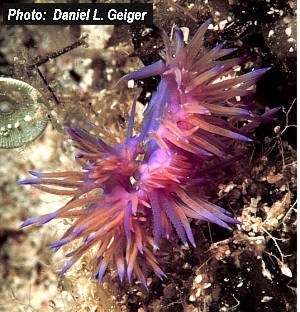
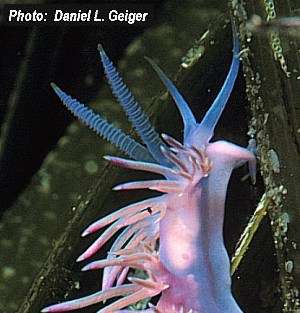
Rudman, W.B., 1999 (July 6) Flabellina affinis (Gmelin, 1791). [In] Sea Slug Forum. Australian Museum, Sydney. Available from http://www.seaslugforum.net/find/flabaffi
Related messages
Flabellina affinis from the Israeli Mediterranean
August 4, 2008
From: Dani Barchana
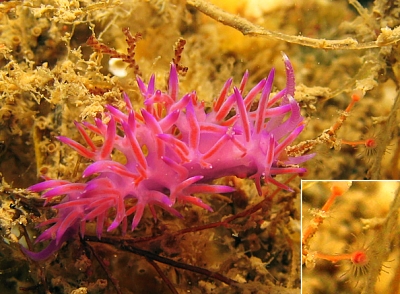
Concerning message #20872:
Since I have seen no photo of Flabellina affinis from our region of the Mediterranean, I thought I should add some. They are very common at depth between 20-30 meters, less in shallower waters.
Locality: Caesareia area, 25-30 meters, Israel, Mediterranean, 24 April 2008, reef. Length: 3 cm. Photographer: Dr. Dani Barchana.
Dr. Dani Barchana
dani.barchana@gmail.com
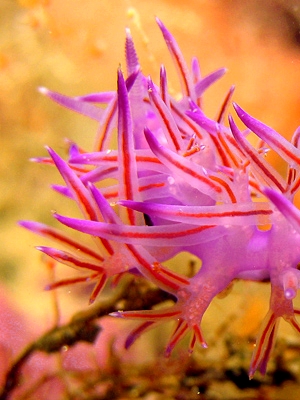
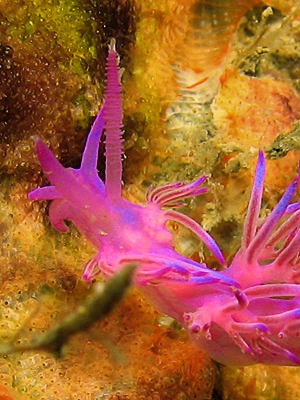
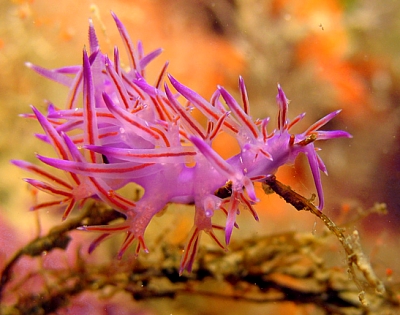
Dear Dani,
Thanks very much for the record. Your photos also illustrates a point raised in one of Dominique Horst's recent messages [#21502] about food colour. In this case we can see the colour of the digestive gland in the cerata is identical to the colour of the hydroid polyp the aeolid is undoubtedly feeding on.
I have also included some close-ups to show the similarities and differences between this species and F. ischitana. Both are very similar in colour, both have regular rings on the rhinophores and cerata arranged on common bases, but in F. affinis there is an opaque purple band below the ceratal tip which obscures our view of the upper end of the digestive gland duct. This purple band is absent in F. ischitana.
Best wishes,
Bill Rudman
Another Flabellina from the French Mediterranean
April 16, 2008
From: François Zylberman
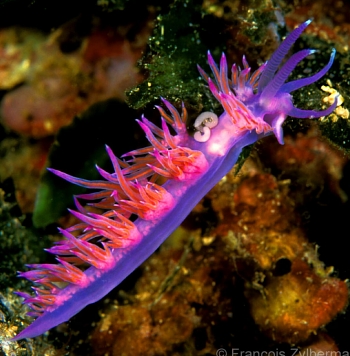
Dear Bill,
Could you help me to identify this other aeolid ? It's perhaps a Flabellina?
Some gills are just behind the head.
Locality: Antibes, 20m, France, Mediterranean Sea, August 2003. Photographer: François Zylberman.
Many thanks
François Zylberman
www.geodia.com
francois@geodia.com
Zylberman, F., 2008 (Apr 16) Another Flabellina from the French Mediterranean. [Message in] Sea Slug Forum. Australian Museum, Sydney. Available from http://www.seaslugforum.net/find/20872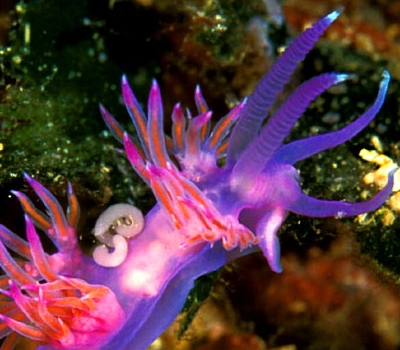
Dear François,
In your other message [#20871] about Flabellina ischitana I mentioned there was another very similar species which differed in having an opaque purple band just below the ceratal tip. You can see it clearly in your photo, which would make it Flabellina affinis. The ceratal groups in your photo in the present message don't seem to be on such obvious basal stalks but I suspect they are very contracted in this photo.
In this photo you can also see the fine rings on the rhinophores. They are also present in F. ischitana but are not so clearly seen in your earlier photo. The two white sausage-shaped structures behind the first ceratal clusters are I guess what you describe as 'gills'. They are in fact the egg sacs of a parasitic crustacea living in the body cavity of the aeolid. Have a look at the messages attached to the opisthobranch parasite page for more information
Best wishes,
Bill Rudman
Flabellina affinis from the French Mediterranean sea
August 16, 2007
From: Dominique Horst
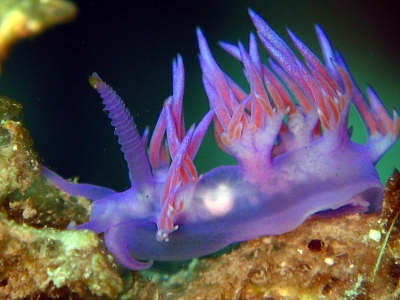
Hello,
As the body of this Flabellina affinis is rather transparent, a white bean is visible in the central position. Could this be the heart or any digestive gland ?
Locality: Cap d'Antibes, 12m, France, Mediterranean sea, 08 July 2007. Length: 25mm. Photographer: Dominique Horst.
Kind regards,
Dominique
dominique.horst@wanadoo.fr
Horst, D., 2007 (Aug 16) Flabellina affinis from the French Mediterranean sea. [Message in] Sea Slug Forum. Australian Museum, Sydney. Available from http://www.seaslugforum.net/find/20172Dear Dom,
The only structure I know that gets this opaque white appearance is the ampullar region of the reproductive system where the animal's sperm is stored. It is only noticeable like this when the animal is mature and the ampulla packed full of sperm.
Best wishes,
Bill Rudman
Colour of egg masses
May 31, 2007
From: David Shepherd
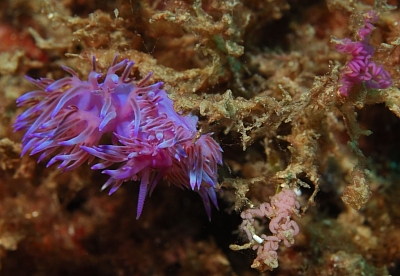
Greetings,
I thought these may be of interest to you. There appears to be two mating nudibranch with different coloured eggs visible.
Can you name the species, please.
Locality: Tascon Petit, Costa Brava, 8.8 metres, Spain, Mediterranean Sea, 29th August 2006, rock, covered with vegetation. Length: 30mm.. Photographer: David R Shepherd.
David R Shepherd.
daveshepherd562@tiscali.co.uk
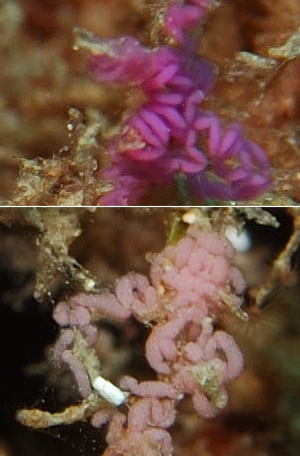
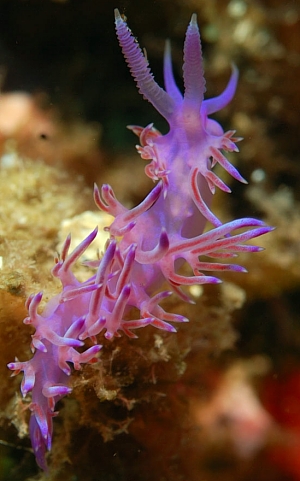
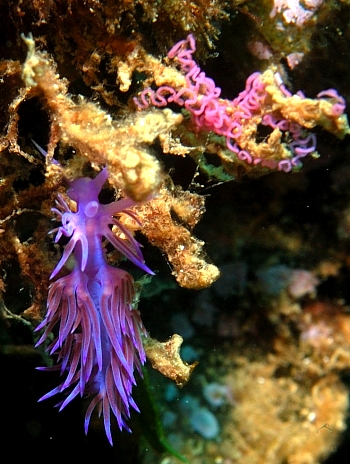
Dear Dave,
The animal is the aeolid Flabellina affinis and I suspect all the egg masses in your photo are from this species, if not the same animal. In this case the darker coloured eggs are the most recently laid. As the eggs develop inot larvae and develop shells before hatching they lose some of their colour.
Best wishes,
Bill Rudman
Flabellina ischitana vs F.affinis
May 30, 2007
From: Dominique Horst
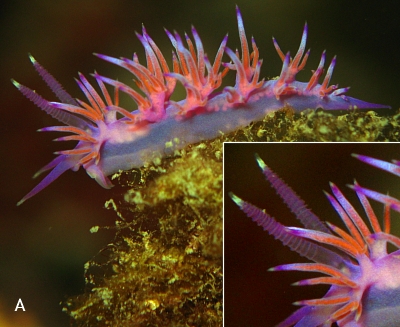
Hi Bill,
Having a look at pictures I've taken from Flabellina affinis and Flabellina ischitana and the description about the differences made by the authors, I still don't feel comfortable on some identifications. I have initially identify the 3 animals as F. ischitana, but I would say now that A and B-C are more probably F. affinis, even D may be ?
Locality: Cap d'Antibes, 18m, France, Mediterranean sea, 22 August 2006, rocks. Length: 20mm. Photographer: Dominique Horst.
If you could help me on these, I would be very pleased.
Many thanks and kind regards,
Dominique
dominique.horst@wanadoo.fr
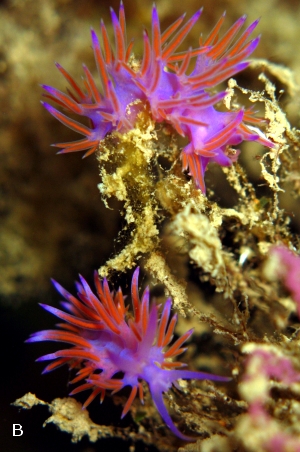
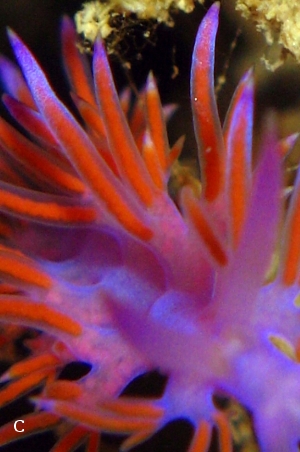
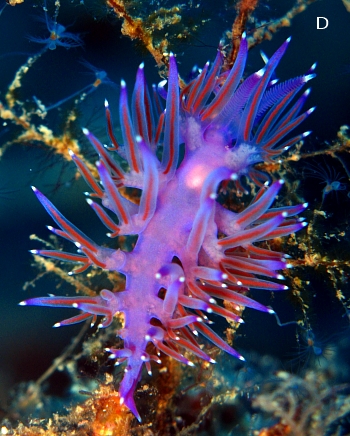
Dear Dominique,
My understanding is that in Flabellina ischitana the ceratal surface is translucent, without violet colouration, while in Flabellina affinis the zone under the subapical white ring is opaque violet, obscuring the digestive gland. Looking closely at your photos I would say all of these are F. affinis.
Best wishes,
Bill Rudman
Flabellina affinis with copepods
August 24, 2006
From: Dominique Horst
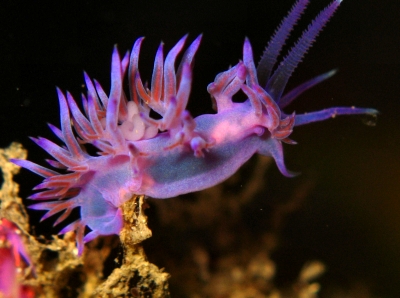
Concerning message #17130:
Dear Bill,
That's incredible, I was far from imagining this. And now it seems that for these copepods it's time for laying. Here is another slug, Flabellina affinis, with eggs coming out on the back...
I have had a look to all my photos taken in the previous months, but none are showing this. It's may be the season now...
Locality: Cap d'Antibes, 18m, France, Mediterranean sea, 19 August 2006, vertical rock. Length: 20mm. Photographer: Dominique Horst.
Thanks again for your continuous help on this great forum.
Dominique
dominique.horst@wanadoo.fr
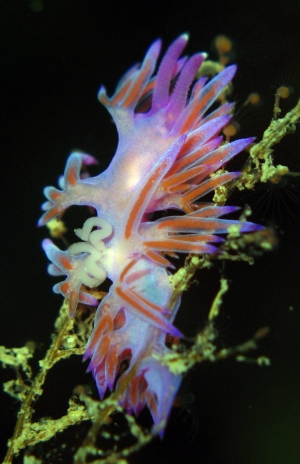
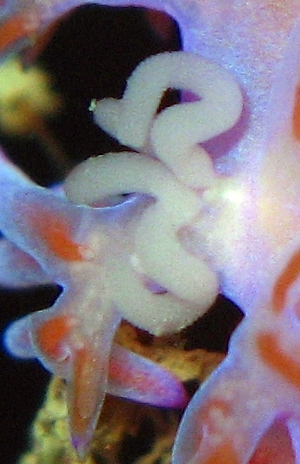
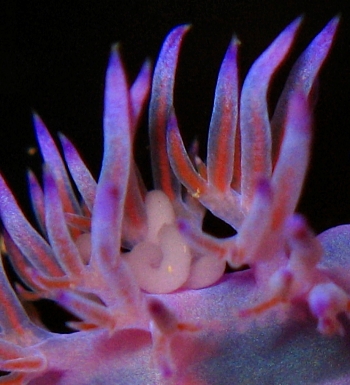
Dear Dominique,
By chance, I am pretty sure one of the Cratena peregrina in your other message [#17516 ] has a copepod as well. The Mediterranean seems to be a good place for this copepod - nudibranch association ... although I doubt that the nudibranchs would consider it 'good'.
Best wishes,
Bill Rudman
Re: Flabellina ischitana from Portugal
April 25, 2006
From: Marina Poddubetskaia Ossokine
Concerning message #16335:
Dear Bill and David,
I think this animal is Flabellina affinis. In this species only the ceratal tips are obscured by violet/purple tinge, exactly like in this animal.
We also have this species in Arcachon Bassin, on the Atlantic coast of France.
Best regards,
Marina.
nembro@nembro.info
Poddubetskaia Ossokine, M., 2006 (Apr 25) Re: Flabellina ischitana from Portugal. [Message in] Sea Slug Forum. Australian Museum, Sydney. Available from http://www.seaslugforum.net/find/16444Dear Marina,
My mistake - thanks for letting me know
Best wishes,
Bill Rudman
Re: Flabellina ischitana from Portugal
April 25, 2006
From: Juan Lucas Cervera
Concerning message #16335:
Hi Bill,
This is Flabellina affinis. See the text of the Fact Sheet about this species.
Regards.
Lucas.
lucas.cervera@uca.es
Cervera, J.L., 2006 (Apr 25) Re: Flabellina ischitana from Portugal. [Message in] Sea Slug Forum. Australian Museum, Sydney. Available from http://www.seaslugforum.net/find/16450Dear Lucas,
Thanks for sending me back to my Fact Sheet.
'in Flabellina affinis the zone under the subapical white ring is opaque violet'
I can see now why I have been confusing myself. I have interpreted 'the zone under the subapical white' to be the rest of the ceras, when in fact it means just a band below the white. So all my confusion has been based on my ambiguous writing. I have slightly altered the sentence so I hope it is now quite clear - hopefully I will now get it right in future
Best wishes,
Bill Rudman
Flabellina ischitana from Portugal
April 24, 2006
From: David Abecasis
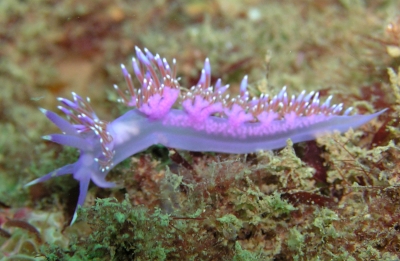
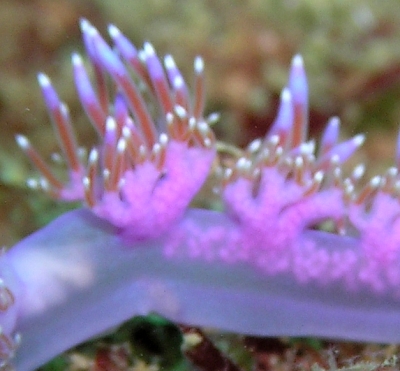
Here's what I think is a great picture of Flabellina affinis.
Locality: Faro, 16 metres, Portugal, Atlantic Ocean, 13 April 2006. Photographer: David Abecasis.
Best regards,
David Abecasis
davidbecas@netcabo.pt
Abecasis, D., 2006 (Apr 24) Flabellina ischitana from Portugal. [Message in] Sea Slug Forum. Australian Museum, Sydney. Available from http://www.seaslugforum.net/find/16335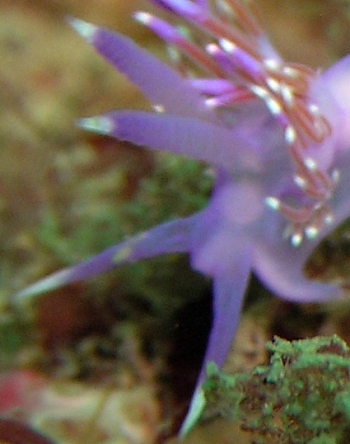
Note added 25 April: This is indeed F. affinis. My mistake - Bill Rudman
Dear David,
It is a nice photo but I think it is of Flabellina ischitana. It is very similar in colour to F. affinis but one colour difference is that in F. affinis the ceratal digestive gland duct is obscured by a purplish dusting over the ceratal wall. In this animal the reddish digestive gland is clearly visible through an apparently transparent ceratal wall. The pinkish lobules filling the base of the ceratal stalks are the ovotestis.
I would appreciate some feedback on this please Lucas?
Best wishes,
Bill Rudman
Re: Flabellina ischitana ? from the Canaries
April 5, 2006
From: Marina Poddubetskaia Ossokine
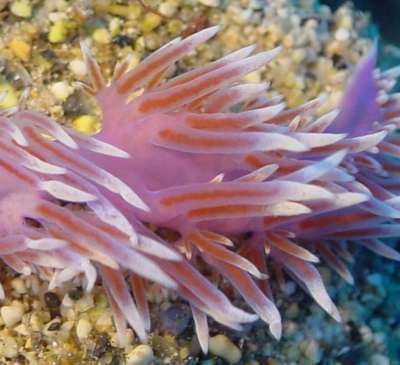
Concerning message #16166:
Dear Bill,
I sent Lucas Cervera some larger photos of this Flabellina and here is his answer :
================
Marina,
Seeing with detail your photos and the egg masses, I think that all specimens are Flabellina affinis. Under the white tip, it is possible to see a light violtet/pink shadow that is not present in F. ischitana. In other specimens this violet pigmentation is darker and wider. This belongs to the intraspecific variability.
Cheers.
Lucas.
================
Locality: 'Veril Grande' , Jandia , 26m, Fuerteventura, Canary Islands, Atlantic Ocean, 9 March 2006, rocks and sand. Length: 30mm. Photographer: Marina Poddubetskaia Ossokine.
Best wishes,
Marina.
Nembro website
nembro@nembro.info
Poddubetskaia Ossokine, M., 2006 (Apr 5) Re: Flabellina ischitana ? from the Canaries. [Message in] Sea Slug Forum. Australian Museum, Sydney. Available from http://www.seaslugforum.net/find/16239Thanks Marina,
Bill Rudman
Re: Flabellina ischitana ? from the Canaries
March 25, 2006
From: Juan Lucas Cervera
See message #16239 suggesting it is F. affinis
Concerning message #16148:
Dear Marina and Bill,
I think that the specimen photographed by Marina could be Flabellina ischitana.
F. ischitana and F. affinis are sympatric species in southern Iberian Peninsula and you can find together on the same hydroid. On the other hand, in my knowledge with specimens of such area, the egg masses of both species are different in color, white and pink respectively.
I have no data about the possibility of a color change from white to pink for the F. ischitana 's egg masses. Maybe Marina has found specimens of F. ischitana close to a F. affinis' egg mass.
Marina, did you see the specimen of "F. ischitana" laying a pink egg mass? If you did, maybe your animal is F. affinis, with a very tiny deep violet surrounding area under the opaque white subapical ceratal area.
Sorry...
Regards.
Lucas.
lucas.cervera@uca.es
Cervera, J.L., 2006 (Mar 25) Re: Flabellina ischitana ? from the Canaries. [Message in] Sea Slug Forum. Australian Museum, Sydney. Available from http://www.seaslugforum.net/find/16166Re: Flabellina affinis & eggs from Canary Ids
March 25, 2006
From: Juan Lucas Cervera
Concerning message #16147:
Dear Marina and Bill,
This species is Flabellina affinis.
Regards.
Lucas.
lucas.cervera@uca.es
Cervera, J.L., 2006 (Mar 25) Re: Flabellina affinis & eggs from Canary Ids. [Message in] Sea Slug Forum. Australian Museum, Sydney. Available from http://www.seaslugforum.net/find/16165Thanks Lucas,
Best wishes,
Bill Rudman
Flabellina ischitana ? from the Canaries
March 24, 2006
From: Marina Poddubetskaia Ossokine
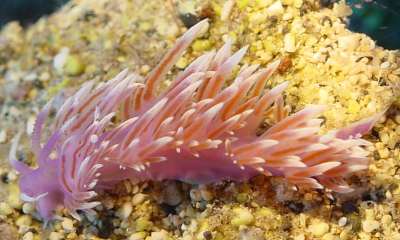
Dear Bill,
In addition to my previous message [#16147] here is the second Flabellina species found in Fuerteventura, together with Flabellina affinis.
Under the water I was convinced it was Flabellina ischitana, because these animals were very similar to Mediterranean F. ischitana. On your F. ischitana fact sheet, the geographical distribution is the Mediterranean only. But some months ago Lucas Cervera told me that there are some records of this species published in Western Andalusia and Portugal (Atlantic). So, I wouldn't be surprised to find it in Canary Islands too.
Locality: 'Veril Grande' , Jandia , 26m, Fuerteventura, Canary Islands, Atlantic Ocean, 9 March 2006, rocks and sand. Length: animal : 30 mm / eggs : 18-20 mm. Photographer: Marina Poddubetskaia Ossokine.
But the detail which makes me doubt about this ID is the related egg-mass.
The bunch of hydroid on which I found these 2 Flabellina species and eggs were far from any other fixed fauna. So, animals seemed completely restricted to it. The egg-masses visible on the photo seem to belong to 2 different species too. The bright pink egg-ribbon obviously fit Flabellina affinis present here. So, by a process of elimination, the pale pink egg-ribbon might belong to the second Flabellina species.
In their redescription of Flabellina ischitana (1998), Lucas Cervera, Garcia-Gomez and Lopez-Gonzalez write that the egg-ribbon is white in this species, not pink.
Also, in message #1039, Lucas Cervera is speaking about another pink Flabellina species I've never seen to compare with: F. alternata.
That's why I wanted to share my questioning with you and to ask your opinion on this animal.
Best wishes,
Marina.
Nembro website
nembro@nembro.info
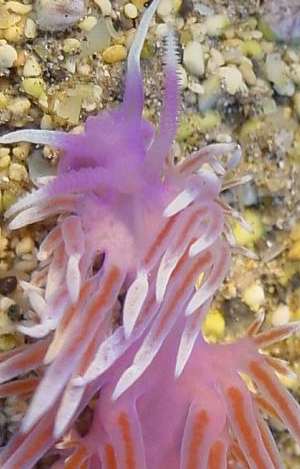
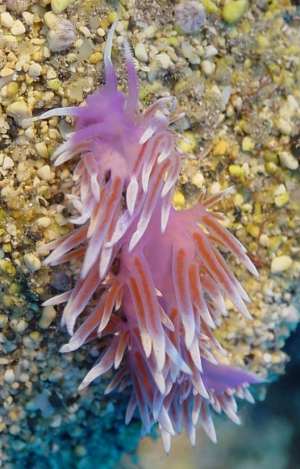
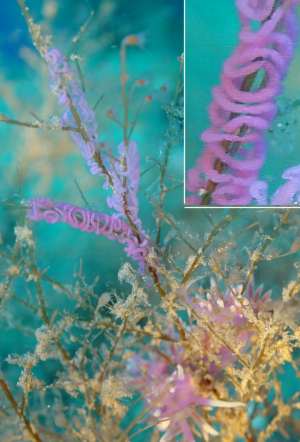
See Lucas Cervera's message #16239 suggesting it is F. affinis
Dear Marina,
The exciting thing about this work is that we learn new things all the time. Certainly if you read a species is restricted to the Mediterranean it would not be surprising if it is found on the Atlantic coast just north and south of the Straits of Gibraltar. We just don't know enough as yet. The same with egg mass colour. Perhaps the egg masses change from white to purple during development or perhaps both purple and white egg masses are produced in one species. But then again you have an earlier photo on the Forum [message #7344] showing a white egg ribbon for F. ischitana.
My understanding is that F. alternata has the rhinophore lamellae - or really broken rings - arranged in an alternating pattern but in your animal the rings seem to be complete. It's hard to be sure but they look larger and thinner, and less rounded at the edge than in your photo of F. affinis. The ceratal wall is fairly transparent, which is a character of F. ischitana, but it looks quite like the cerata in your other message [# 16147] so I think I will wait until we get comments from Lucas Cervera
Best wishes,
Bill Rudman
Flabellina affinis & eggs from Canary Ids
March 24, 2006
From: Marina Poddubetskaia Ossokine
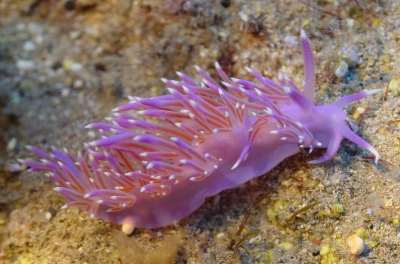
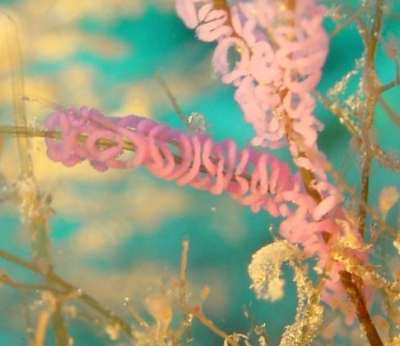
Dear Bill,
Recently I spent one week diving in Fuerteventura, one of the 7 Canary Islands. The bottom consisted mainly in the sand and even few rocks present here weren't really covered in fixed fauna, or very little. Under the rocks there were some hidden fauna but no sea slugs. In one week I've seen only 2 nudibranch species, both pink Flabellina found together on an hydroid, with eggs. It was quite a disappointing stay for diving but nice for the sun and gold beaches.
Let's me show you one of these Flabellina. Even if it is similar to Flabellina arveloi, it looks exactely like Flabellina affinis from the Mediterranean and the bright pink eggs fit this species too. So, I'm quite confident about this ID. But I'm more puzzled about the second species and I will write you about it in a separate message [#16148 ].
Locality: 'Veril Grande' , Jandia , 26m, Fuerteventura, Canary Islands, Atlantic Ocean, 9 March 2006, rocks and sand. Length: animal : 38mm / eggs : 18mm. Photographer: Marina Poddubetskaia Ossokine.
Thank you in advance for your opinion on it.
Best wishes,
Marina.
Nembro website
nembro@nembro.info
Poddubetskaia Ossokine, M., 2006 (Mar 24) Flabellina affinis & eggs from Canary Ids. [Message in] Sea Slug Forum. Australian Museum, Sydney. Available from http://www.seaslugforum.net/find/16147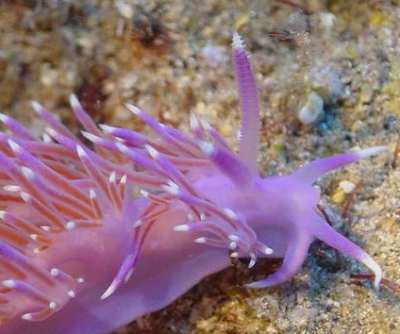
Dear Marina,
These pinky purple Flabellina in the Atlantic [10 species I think] are almost as difficult as the many blue chromodorids. It will be interesting to hear the comments of some local experts.
Best wishes,
Bill Rudman
Flabellina affinis from Portugal
March 24, 2006
From: David Abecasis

Dear Bill,
Here is a photo of Flabellina affinis from Portugal
Locality: near Pedra da Greta, Faro, Portugal. Depth: 16 meters. Length: 3 cm. 11 January 2006. Photographer: David Abecasis
David Abecasis
dabecassis@ualg.pt
Abecasis, D., 2006 (Mar 24) Flabellina affinis from Portugal. [Message in] Sea Slug Forum. Australian Museum, Sydney. Available from http://www.seaslugforum.net/find/15547
Dear David,
Although I can't see the rhinophores I am pretty sure of your identfication. One intersting feature is the white coiled cylindrical structure on the back. I think this is the eggs of a crustacean parasite living in the Flabellina.
Best wishes,
Bill Rudman
Flabellina affinis from Cerbere
August 5, 2003
From: Marina Poddubetskaia
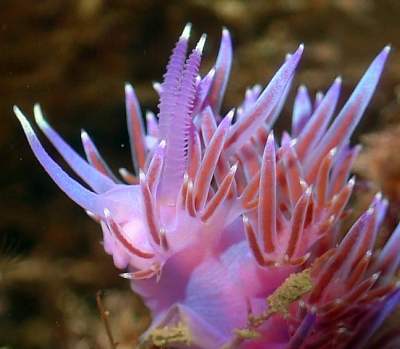
Dear Bill,
Here are some photos of Flabellina affinis and its well known egg-ribbon.
Upper 3 Photos are all of the same animal:
July 03, 2002
Location: Cerbere, France, Mediterranean coast
Site: Pointe aux girelles
Depth: 11m
Size: 15mm
Lower Photo:
July 09, 2003
Location: Cerbere, France, Mediterranean coast
Site: L'Abeille
Depth: 3m
Size: 25mm
Photos: Marina Poddubetskaia - Nembro website
Cordially,
Marina.
nembro@nembro.info
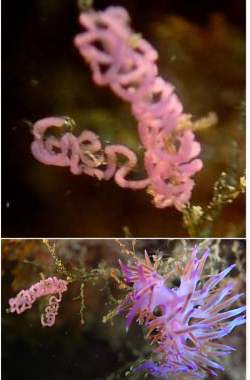
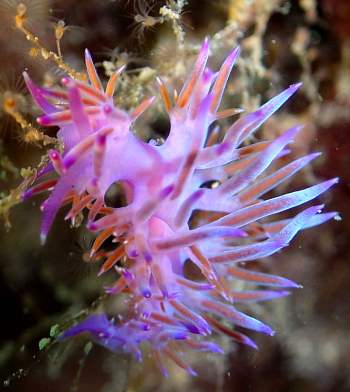
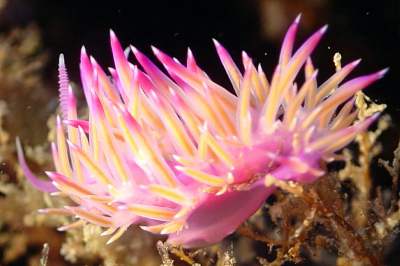
Thanks Marina,
These photos show the lamellae on the rhinophores very clearly, and the way the groups of cerata are arranged on a common stalk
Best wishes,
Bill Rudman
Re: Flabellina affinis? from French Mediterranean
July 2, 2002
From: Marina Poddubetskaia
Dear Bill,
Thank you for your response. To my knowledge, cerata in Flabellina affinis don't join the body directly. Usually, cerata are put together into 'trunks'. But in my animal it isn't so. Is it different in juveniles ?
Best wishes,
Marina.
nembro@nembro.info
Poddubetskaia, M. , 2002 (Jul 2) Re: Flabellina affinis? from French Mediterranean. [Message in] Sea Slug Forum. Australian Museum, Sydney. Available from http://www.seaslugforum.net/find/7399Dear Marina,
Identifying juveniles is always difficult and often involves a degree of guesswork. Adults of both F. affinis and Flabellina ischitana have the cerata arising from a common stalk. As I said in my earlier message I can't see the characteristic lamellae on the rhinophores either. On the basis that it is a purple Flabellina from the Mediterranean, and has purple dusting on the cerata, my best guess is that it is a juvenile Flabellina affinis. Sometimes there is not much to be gained debating the identity of the unidentifiable. If you had the specimen and its identity could be confirmed by looking at its anatomy, then the photo could give us an idea as to what a juvenile of that species looks like. But since we can't positively identify it, we can't really say much else.
Cheers,
Bill Rudman
Flabellina affinis? from French Mediterranean
June 29, 2002
From: Marina Poddubetskaia
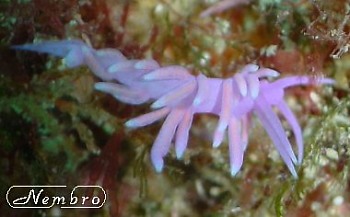
Dear Bill,
Could you help me to identify this Flabellina, please.
Date: June 07, 2002
Location: Cap Croisette (near Marseille), France
Site: Calanque de Pouars
Depth: 11m
Size: less than 1cm
Best wishes,
Marina.
marina.poddubetskaia@orange-sc.com
Poddubetskaia, M., 2002 (Jun 29) Flabellina affinis? from French Mediterranean. [Message in] Sea Slug Forum. Australian Museum, Sydney. Available from http://www.seaslugforum.net/find/7343Dear Marina,
Hopefully someone will let us know if I am wrong but I think this is Flabelina affinis. I can't see any horizontal ridging on the rhinophores but that could be because it is a juvenile. It differs from the very similar looking Flabellina ischitana in having a purple dusting all over the cerata. Though identifying juveniles can be very difficult.
Cheers,
Bill Rudman
Flabellina affinis egg-mass
March 18, 2001
From: Erwin Koehler
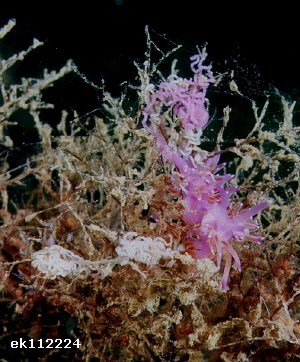
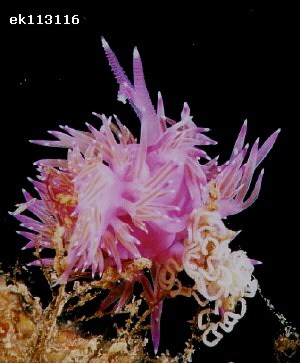
Dear Bill,
Attached are 2 photos of Flabellina affinis with egg-masses:
ek112224 has the purple egg-mass of F. affinis in the background, in front are 2 white egg-masses which I think to be from Cratena peregrina which I have sent a photo of in a separate message.
ek113116 shows a pair of F. affinis on the egg-mass of C. peregina.
I used to think that different species don't live so close together, these 2 are often seen together...
Data:
ek112224: slug 27mm, depth 16m, Spain, Cala Joncols, divesite El Bisba, July 2000
ek112224: slugs ~35mm, depth 9m, Spain, Cala Joncols, divesite La Caverna, July 2000
Erwin
Erwin@medslugs.de
Koehler, E., 2001 (Mar 18) Flabellina affinis egg-mass. [Message in] Sea Slug Forum. Australian Museum, Sydney. Available from http://www.seaslugforum.net/find/3940Thanks Erwin,
Concerning species not living close together. Species tend to live near their food, so species that eat things that no one else eats are usually not found in mixed species groups, but if a number of species feed on the same species of food then you often find a mixed group. In the case of hydroids, where often many species of hydroids form a tangled 'thicket' then again you can find an assortment of aeolids looking for their particular delicacies.
Best wishes,
Bill Rudman
Flabellina affinis
July 7, 1999
From: Bill Rudman
I have added this page on Flabellina affinis to accompany the discussion on Flabellina ischitana.
Bill Rudman.
